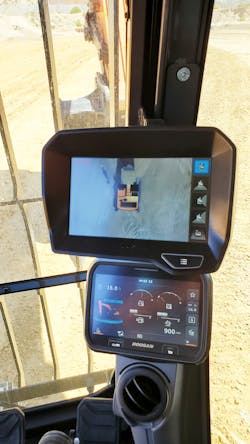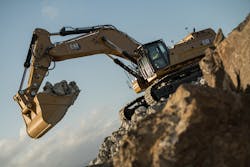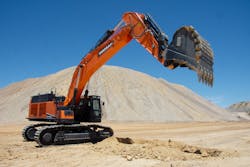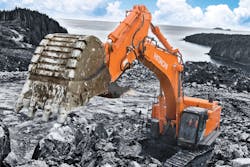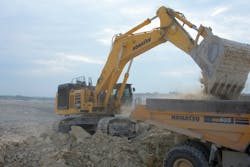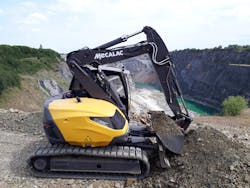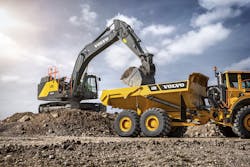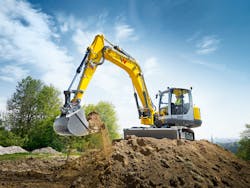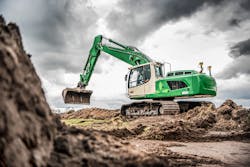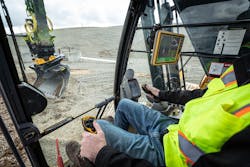Today’s largest excavators are packed with technology that brings more efficiency to the job and keeps them on the job site longer with designs that minimize maintenance.
CAT has standardized specific technologies on its next-generation excavator launch, from the smallest to the 395, its largest onsite non-mining excavator typically used for deep excavations, foundations, and water and sewer projects.
2D grade control is one such technology. The indicate-only system gives operators real-time depth and/or slope to the bucket.
“If they are doing a deep excavation of 10 feet, the operator can set the bucket tooth down on a reference point and put negative 10 feet into the display for real-time depth,” says Ryan Neal, Caterpillar spokesperson.
“If they want to maintain 10 feet deep from where they're sitting, the machine will give them live feed from the bucket tip.”
That’s crucial for such jobs as digging a trench box.
CAT’s payload system provides real-time data for how much material is going into the bucket, how many trucks per day are loaded and the total tons loaded out.
It’s easy to underload a highway truck due to overloading concerns, notes Neal.
“When you’re loading up 30 or even 10 trucks all day and putting in four or five tons less per truck because you're worried about getting overweight tickets, that adds up at the end of the day,” Neal says.
CAT’s payload system delivers plus or minus 3% accuracy, enabling operators to dial in an accurate payload amount per truck, eliminating extra trucks at day’s end, he adds.
CAT also offers E-fence features on all next-generation excavators that are not GC, serving as a “safety bubble” around the operator, says Neal, adding that the protection extends from floor to ceiling and on the left and right.
Lift Assist is a real-time digitized lift chart alerting operators when they’re at the rated load and stability.
Doosan Infracore North America’s three biggest crawler excavators are the DX490LC-5, DX530LC-5, and the newest excavator introduced in 2020, the DX800LC-7. The 539-horsepower excavator weighs approximately 80 metric tons and is designed for big infrastructure projects.
The excavators are commonly used on infrastructure job sites such as new road and bridge projects, says Aaron Kleingartner, Doosan product and dealer marketing manager.
In addition to earthmoving, the excavators also can be used to quickly load articulated dump trucks as bucket capacities can reach up to 5.1 cubic yards. Doosan offers a heavy-duty and severe-duty bucket for use with the DX800LC-7, Kleingartner adds.
The Doosan DX800LC-7 excavator is available with a mass excavation arm. Productivity-based performance features include the D-ECOPOWER system, which precisely optimizes hydraulic oil flow with the excavator’s available horsepower to maximize machine efficiency. Operators also can select from boom or swing priority modes.
The 360-degree all-around view monitor and a new 8-inch standard monitor provide enhanced operator visibility to the excavator's rearview camera, notes Kleingartner.
The Smart Power Control system is designed to increase fuel efficiency by adjusting the excavator’s power to meet the application’s needs, delivering the exact amount of oil needed.
Hitachi Construction & Mining Division’s largest excavator is the ZX870LC-6 with an operating weight of 85,600 kg (188,716 pounds), an EPA Final Tier 4 (FT4)/EU Stage IV Isuzu engine, and 512 hp designed for generous swing torque, digging force, and lift capacity, notes Justin Steger, solutions marketing manager, Hitachi site development and underground.
The reduced-tail-swing excavator is designed to offer optimal power in a confined space and fast cycle times through its TRIAS II three-pump hydraulic technology and tackles jobs in earthmoving, site development, heavy construction, and river dredging.
Hitachi recently rolled out its factory-integrated Solution Linkage 2D and 3D Grade Control for select excavators, including the ZX210-6, ZX210LC-6 and ZX350LC-6.
“This allows an operator to set a grade and hold it without the risk of over-digging to finish jobs more quickly and reduce material cost and fuel costs,” says Steger. “The machine controls the boom and bucket while the operator handles the arm, reducing the need for multiple passes to achieve the correct grade.”
Hitachi recently announced its new ZX Secure service plan, designed to help lower the total costs of ownership of construction excavators.
Komatsu’s largest non-mining excavators are the PC1250LC-11 and PC1250SP-11with 758 FWHP operating at 259,960 to 272,600 pounds.
The excavators are typically used in deep sewer and water excavation, large mass excavation earthmoving jobs, and as the base machine with extended reach booms/arms for material handling applications, aggregate barge unloading, and other bulk materials.
They also are used as the base machine for high-reach demolition applications and steel and concrete demolition.
The latest technology featured on the excavators includes Komtrax Plus, an Iridium satellite advanced telematics system for monitoring machine systems, location, performance, and fuel consumption.
The Komvision camera system offers enhanced operator awareness, says Kurt Moncini, Komatsu senior product manager.
Moncini says the excavators have been designed to make maintenance easier and more cost-efficient through grouped service locations, larger service access doors, and hydraulic return filter restriction monitoring.
They feature a maintenance access walkway/platform for access to fluid compartments, filters, hydraulic systems and pumps.
The excavators feature the capability for installing fluid fast-fill and evacuation systems, a built-in grease container with grease pump and reel for efficient greasing of swing bearing and pins/bushings on boom and arm, and an optional auto lubrication system.
There are service harness tie-off points on the boom and arm, an optional hydraulic access ladder for easier entry and exit to the machine, and relocated air filters for improved service access.
The excavators are Tier 4 Final emissions-compliant without requiring DEF fluid.
The largest of JCB’s eight excavators is the JS370, a 37-ton heavy tracked excavator used to work in demolition and highway construction as well as rock quarries.
The newest machines are the X models, with the largest one being the 220X, a 20-ton tracked excavator.
The JS models such as the JS370 have features such as "basic tool select," enabling operators to preset/preload the auxiliary settings for various attachments, notes Chris Lucas, JCB excavator product manager.
Standard features such as “auto idle” save fuel and add to efficiency, and “auto fan clutch control” for engine cooling automatically adjusts speed/output based on temperature demands, which reduces fuel cost and noise, Lucas says.
The JS370 also offers "auto health check" and real-time monitoring of system errors. The standard JCB Livelink monitors machine health, location, and security.
For ease of maintenance and reduced service time, JCB has improved the hydraulic oil change from 5,000 hours to every 1,000 hours.
JCB offers complete service access on its machines, with the entire engine exposed through panels and the top roof. Flat glass throughout all of the machines makes it less expensive and simpler to replace, Lucas notes.
The excavators come standard-fitted with JCB LiveLink telematics, which also tracks servicing.
“It will alert you in the machine of any kind of service point coming up or some kind of fault on the machine that needs to be reviewed. It is monitored by our LiveLink team at JCB, who will oftentimes know it before the operator even knows it so we can alert the owner or the operator of an issue if there is one,” says Lucas.
None of the JCB excavators require DPF, reducing servicing cost and downtime, he adds.
Mecalac’s largest excavators are the tracked 15MC and the wheeled 15MWR, both weighing approximately 15 tons depending on the configuration.
The excavators are designed to be intuitive and efficient, maximizing safety and operator comfort while providing versatility, notes Peter Bigwood, Mecalac North America general manager.
Mecalac’s 15MWR, as with the entire MWR series, is designed for optimal stability and enhanced lifting performance in part due to its low center of gravity, offering enhanced operator experience with easier and safer accessibility, Bigwood says.
“Despite its lower center of gravity, the MWR series has a high ground clearance, which reduces the risk of damage to the transmission and undercarriage from obstacles on the ground,” says Bigwood.
The 15MWR is nearly 2.5 times more compact than a standard excavator, designed to enhance in-turn mobility in narrow spaces, and is further benefited by the unit’s four-wheel steering.
The 136-horsepower (100-kilowatt) machine can lift as much as 6.5 tons to 9.8 feet (3 meters) at any 360-degree point and has a breakout force of 18,370 pound-force (8,170 decanewtons).
Additionally, the excavator’s two-part boom with offset achieves a reach of 27.2 feet (8.3 meters). The excavator also has a 58-gallon (220-liter) fuel capacity.
Inside the cab, the 15MWR features a central selector with park, road, and work modes with a single turn of a dial. Visibility is provided through a low hood height.
The 15MC shares similar breakout forces and horsepower as the 15MWR, with the major difference, is it being tracked instead of wheeled. It is designed to lift almost 50% of its weight to a height of 9.8 feet (3 meters).
Its nearly 29.5 feet (9 meters) working capacity is designed for optimal in-cab visibility due to the two-piece boom, which also enhances maneuverability and optimizes the work-tool carrier placement capabilities.
Volvo Construction Equipment offers 10 large size class excavator models from 25 tons to 100 tons.
Two crawler excavator models—the EC250E and EC300E—also come with a hydraulic hybrid option that’s expected to be offered on other large excavators in the coming months.
The largest model, the 100-ton EC950F crawler excavator, is designed to offer power and stability to handle high capacities in tough applications, notes Sejong Ko, product manager, excavators, Volvo CE.
“It’s equipped with a 603 hp (450kW) Volvo D16 Tier 4 Final engine that delivers high torque at low RPM and is designed for fast and efficient on-site production,” says Ko. “Pairing the EC950F with the Volvo A60H articulated hauler is where contractors can realize extreme productivity potential. The EC950F fills the 60-ton, 33.6 cubic meters (43.9 cubic yards) haul truck in just four bucket passes.”
The newest additions to the Volvo large excavator lineup include two 50-ton class machines, the EC530E and EC550E.
“The EC550E is designed to provide the levels of durability and performance more commonly expected from a 60-ton machine, making it the perfect choice for heavy-duty digging, mass excavation, and large site preparation,” says Ko. “The EC530E is a true 50-ton excavator delivering up to 25% more fuel efficiency and boosting productivity by up to 20%.”
Volvo crawler excavators feature the Dig Assist machine control system, allowing operators to level sites, dig trenches, grade slopes, or create complex, multidimensional site profiles from the cab.
Powered by the Volvo Co-Pilot in-cab tablet and incorporating sensors and the latest GPS technology, Dig Assist is designed “to deliver incredible excavation accuracy in a fraction of the time normally taken using conventional methods,” says Ko.
Volvo excavators also support ActiveCare Direct, its telematics monitoring and fleet utilization service.
The Volvo EC250E and EC300E hybrid option enable excavators to utilize the boom down motion to charge an accumulator with the stored energy driving an assist motor to lower the engine torque requirement, says Ko.
“The result is better fuel efficiency, lower fuel consumption, and a reduction in CO2 emissions while delivering the same power and performance contractors expect from a conventional machine,” says Ko.
Wacker Neuson’s largest excavators are the ET145 14-ton tracked excavator and the EW100 10-ton wheeled excavator.
The ET145 is designed to combine the productivity of a larger crawler excavator with the versatility and accessibility of a compact excavator, notes Jay Quatro, commercial product manager, Wacker Neuson.
“Typical applications are heavy utility work in confined spaces, public works applications in urban areas, and residential construction with limited space,” he adds. “The ET145 is available with rubber or hybrid tracks allowing the machine to access finished surfaces without leaving marks or steel tracks, the best choice for demolition applications. The machine produces a breakout force of 20,500 pounds and a digging depth of 18 feet.”
The EW100 wheeled excavator meets the needs of contractors requiring traditional compact excavating in a highly mobile platform, says Quatro.
“Designed to replace a traditional tracked excavator or backhoe, the EW100 can work in a lane of traffic and transition quickly between job sites with a top speed of almost 19 mph,” he adds. “The EW100 has a breakout force of 11,300 pounds and a max digging depth of 14 feet.”
The ET145 offers a swivel boom allowing access to an increased excavation area on the right and left.
A standard triple boom offers increased digging area through an extended digging range, enabling operators to reach farther, dig closer to the blade, and reach under the machine when needed.
“Since the EW100 is commonly used to dig along roadways and in confined areas, the ability to dig closer to the machine provides more flexibility and reduces the amount of time needed to reposition the machine,” Quatro says.
Wacker Neuson’s excavators are designed for easy service with quick access to all components to save time and money, says Quatro.
Grade control technology for excavators continues to become more intuitive, advanced, and automated, notes Cameron Clark, Trimble Civil Construction earthmoving business area manager.
The recent Trimble Earthworks Grade Control Platform version includes augmented reality functionality for excavators, enabling users to easily understand 3D models, cut/fill information, slope data, bench points, and reference points on the in-cab display in context, Clark notes.
Excavator automatics is an important feature of today's excavator machine control systems.
With Trimble Earthworks, when the excavator is placed in Autos mode, the operator controls the stick and Trimble Earthworks controls the boom and bucket to stay on grade, reduce overcut, and increase production, Clark says.
That allows operators to achieve grade consistently, with high accuracy and in less time, says Clark, adding accuracy is increased by as much as 100% for beginner and intermediate operators and up to 75% for experienced operators.
Today’s excavator machine control systems also can ease the process of connecting the field and the office.
Trimble Earthworks integrates with Trimble WorksManager software to transfer 3D models to or from the office wirelessly and automatically.
“Using the Android operating system, users can download other applications that provide the operator with additional useful tools inside the cab,” says Clark, adding contractors can use the Trimble TD520 display or a third-party Android device.
Trimble Earthworks runs on a 10-inch Trimble TD520 touchscreen display with colorful graphics, natural interactions and gestures, and self-discovery features.
Topcon machine control systems are being used on simple earthmoving projects from underwater projects and all points between, notes Philippe Grevendonck, manager, product management for excavation solutions, Topcon Positioning Group.
“We see that the contractors involved in underwater excavation projects—dredging, pond and lake expansions, creation of boat landings, waterfront cleanups, among others—have become some of the most ardent supporters of GNSS-based solutions,” he says.
“They’ve found that the ability to ‘see’ beneath the surface with their machines has proven invaluable in improving overall efficiency and minimizing the risk of over/under cutting.”
“On-board information gives the operator the overview of what to do and possibility to work towards the greatest accuracy regardless of the type of project,” he adds.
The latest technology Topcon has introduced for excavators is the X-53x Automatic Excavator system for 3D control. The system is designed to control depth of excavation automatically as well as the angle of the boom and bucket at all times while following the design.
“The operator can automatically control the digging depth and bucket angle, executing the work using imported design files or creating custom designs from the cab, using the bucket to take the topo measurements,” says Grevendonck.
“Automated control is changing the earthmoving process,” he points out. “In addition to the new 3D fully automatic solution, we offer 2D systems and 3D indicate systems that are cost-effective ways to get to grade as well.”
